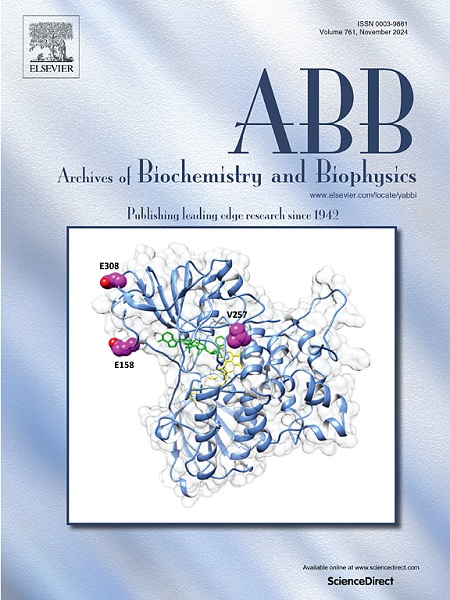Lipid saturation modulates the interaction of anastrozole with biointerfaces
IF 3.8
3区 生物学
Q2 BIOCHEMISTRY & MOLECULAR BIOLOGY
引用次数: 0
Abstract
The interaction of anastrozole, an anticancer drug, with lipid biointerfaces was investigated using Langmuir monolayers of DPPS (saturated lipid) and POPS (unsaturated lipid) to model different membrane environments. Surface pressure-area isotherms revealed that anastrozole induced a slight condensation in DPPS monolayers, while significantly condensing POPS at higher surface pressures, indicating attractive interactions with the unsaturated lipid. The surface dilatational modulus remained largely unaffected for DPPS but decreased for POPS, highlighting a reduction in the surface elasticity. Brewster Angle Microscopy (BAM) images showed the formation of domains in anastrozole-POPS monolayers, whereas DPPS monolayers retained a homogeneous morphology. Infrared spectroscopy indicated that anastrozole increased the conformational order of DPPS alkyl chains while decreasing order in POPS, further supporting the lipid-specific effects of the drug. These findings suggest that lipid saturation plays a critical role in modulating drug-lipid interactions, with anastrozole exhibiting a higher affinity for unsaturated lipids, potentially influencing its bioavailability and mechanism of action at biomembrane interfaces. The results provide insights into the physicochemical behavior of anastrozole in lipid-rich environments, which may be relevant for drug delivery and therapeutic applications.

脂质饱和度调节阿那曲唑与生物界面的相互作用。
研究人员利用 DPPS(饱和脂质)和 POPS(不饱和脂质)的朗缪尔单层来模拟不同的膜环境,研究了抗癌药物阿那曲唑与脂质生物界面的相互作用。表面压力-面积等温线显示,阿那曲唑在 DPPS 单层中诱导轻微的凝结,而在较高的表面压力下则显著凝结 POPS,这表明阿那曲唑与不饱和脂质之间存在吸引力相互作用。DPPS 的表面压缩模量基本不受影响,但 POPS 的表面压缩模量却有所下降,这表明压缩表面弹性有所降低。布氏角显微镜(BAM)图像显示,阿那曲唑-POPS 单层中形成了畴状结构,而 DPPS 单层则保持了均匀的形态。红外光谱显示,阿那曲唑提高了 DPPS 烷基链的构象顺序,同时降低了 POPS 的顺序,进一步证明了该药物的脂质特异性效应。这些发现表明,脂质饱和度在调节药物与脂质的相互作用中起着关键作用,阿那曲唑对不饱和脂质具有更高的亲和力,可能会影响其在生物膜界面的生物利用度和作用机制。研究结果为了解阿那曲唑在富脂环境中的理化行为提供了见解,这可能与药物输送和治疗应用有关。
本文章由计算机程序翻译,如有差异,请以英文原文为准。
求助全文
约1分钟内获得全文
求助全文
来源期刊

Archives of biochemistry and biophysics
生物-生化与分子生物学
CiteScore
7.40
自引率
0.00%
发文量
245
审稿时长
26 days
期刊介绍:
Archives of Biochemistry and Biophysics publishes quality original articles and reviews in the developing areas of biochemistry and biophysics.
Research Areas Include:
• Enzyme and protein structure, function, regulation. Folding, turnover, and post-translational processing
• Biological oxidations, free radical reactions, redox signaling, oxygenases, P450 reactions
• Signal transduction, receptors, membrane transport, intracellular signals. Cellular and integrated metabolism.
 求助内容:
求助内容: 应助结果提醒方式:
应助结果提醒方式:


